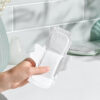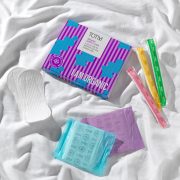Half of the world’s population has a vagina, but for many of us, there’s a lot left to learn.
We’ve pulled together our top 6 good-to-know facts about vaginas that we hope will educate, demystify and help you get to know yours a little better…
1. Your vagina is not your vulva
Historically, the word vagina has been used as a catch-all name for female genitals. Many will use the word “vagina” when they really mean “vulva”, and a recent YouGov survey found that almost half of British women are unable to correctly identify a vagina on a diagram.
We think it’s important to know the difference and both words to be normalised – so here’s the difference. Your vulva is outside of your body, it includes your labia, clitoris, vaginal opening, and the opening to the urethra. Your vagina is part of your internal sexual anatomy. It’s the muscular canal that connects your vulva with your cervix and uterus. It’s how menstrual blood and babies leave the body and where tampons and menstrual cups go into it.
2. Your vagina can grow up to three times in size
When it comes to vaginal childbirth, your vagina can stretch up to three times in size to accommodate a baby as it travels from the uterus through the birth canal. To put this into numbers, the average diameter of a vagina is 3cm and the average head span of a newborn is 10cm. The walls of a vagina are incredibly elastic and pleated, so the sides can separate and widen and return to its usual size over time.
3. Your vagina is self-cleaning
Yup – your vagina cleans itself with perfectly natural secretions or discharge. Discharge helps to prevent and fight infections. The amount of discharge produced can vary depending on where you are in your menstrual cycle. For example, you might experience more discharge when you’re ovulating or pregnant.
There are also a lot of bacteria inside the vagina that protect it and maintain its natural pH level (less than 4.5). Using products like douches, scented wipes and vaginal deodorants to clean the vagina isn’t necessary and can actually disrupt its healthy, natural balance and cause irritation.
Using a natural, unperfumed soap to wash your vulva each day should be enough to maintain good vaginal hygiene. But, if you’re ever concerned, remember you can always speak to your GP.
4. Your vagina is angled
If you’ve ever tried to insert a tampon and felt as though you’ve hit a wall, it’s because you probably have. Your vagina is tilted at a roughly 130-degree angle so it can often feel easier to insert a tampon by aiming it towards your lower back.
5. Your vagina can workout
Not all workouts have to happen in a gym. Kegel exercises, also known as pelvic floor muscle training, can be done anywhere and anytime. There are lots of factors that can cause your pelvic floor to weaken over time – pregnancy, childbirth, ageing, surgery etc. But strengthening your vaginal muscles can help to support your uterus, bladder, small intestine and rectum.
Here’s a simple Kegel exercise for you to try and make part of your daily routine:
1. To properly identify your pelvic muscles, imagine stopping peeing midstream
2. Hold this for a count of three, then relax for a count of three
3. Aim for three sets of 10-15 repetitions a day
6. You can’t lose things in your vagina
Although it is possible for an object to feel stuck in the vagina, only sperm or blood can pass through the cervix at the top of your vagina. Objects like tampons and menstrual cups are far too big to move beyond the cervix and further into your body.
If ever you do experience an item becoming lodged in your vagina, staying relaxed is key. You will usually be able to retrieve an item using your fingers or your pelvic floor muscles to push it into a more reachable position. However, if you are struggling to remove any object yourself, it’s always best to seek medical help.
Have you learnt anything new or know any interesting facts we’ve missed? Join in the conversation on socials and tag us in your #PeriodPowerful posts. You can shop our organic cotton pads here.
Header illustration credit to Nia Beynon Illustrations.





